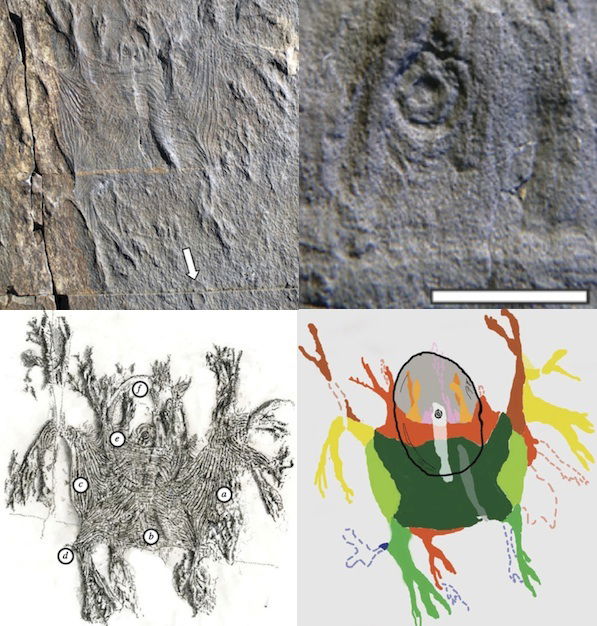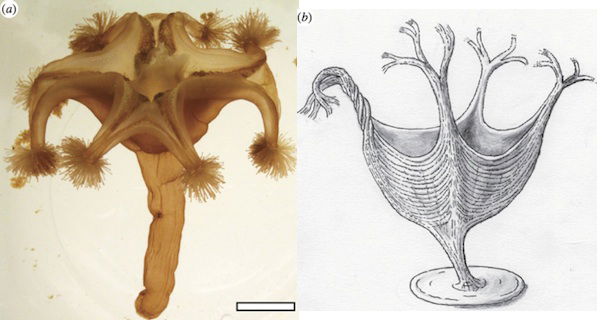
Muscles Appear Deep in the Fossil Record
News to Know
Abstract
Animals were flexing their muscles even “before” the Cambrian Explosion.
News Source
When did animals develop specialized tissues like muscles? Evolutionary scientists report discovery of “the earliest known evidence for preservation of muscular tissue in the geological record.”1 The exquisitely preserved fossilized animal from an Ediacaran rock formation in Newfoundland not only has easily discernible striated muscle bundles, but Haootia quadriformis even appears to have been contracting some of its muscles as it was catastrophically buried.
Four-Fold Symmetry and Flexibility
The muscular little animal, an extinct cnidarian, was flattened to a 49 x 72 mm rectangle of fibrous branches consisting of parallel strands flanking a large disc. A holdfast is clearly visible at the animal’s base. Cnidarians are the taxonomic phylum that includes jellyfish, sea anemones, and coral. The fossilized disc with concentric circles probably represents its central mouth or gastric cavity.
Paleontologists reporting in Proceedings of the Royal Society B reconstructed the flattened fossil and realized it was actually symmetrical in four directions, not just two. Dubbed Haootia quadriformis, its species name reflects its four-way body symmetry. The regularly arranged fibrous branches were flexible in life, as suggested by the way the branches seem to have been twisted and rotated in the water before being suddenly squashed flat. Their original flexibility is also “demonstrated by 180 degree changes in direction of some examples to face the predominant flow direction,” the water flow direction being inferred from the alignment of other nearby fossils.1

Meet Haootia quadriformis, a fossilized cnidarian from Ediacaran rock in Newfoundland, Canada. Despite having been preserved in rock conventionally dated at least 560 million years old, this animal’s well-defined muscles are preserved. The arrow indicates a holdfast, shown close-up in the second photograph. As seen in the fossil’s photo (top) and designated in the line drawing, muscle bundles with typical striations appear in (a), (b), and (c). Those in (a) and (c) appear to be contracting and correspond to the light green bulges in the color illustration. Twisting fibers are labeled (d) and superimposed fibers from this flattened fossil are labeled (e). The large circular disc (f) is thought to represent a mouth or gastrocoel. When corrected for the deformation of the rock surface, this disc is perfectly circular. Scale bar=5 mm. Images: A. G. Liu et al., “Haootia quadriformis n. gen., n. sp., interpreted as a muscular cnidarian impression from the Late Ediacaran period (approx. 560 Ma),” Proceedings of the Royal Society B 281 (2014): 20141202, dx.doi.org/10.1098/rspb.2014.1202.
Flexing with Finality from the Pre-Flood World
The fibers, upon close inspection, look like symmetrically arranged bundles of striated muscle. One pair of these muscles appears to have been bulging as a muscle does when contracting. (See the bulging fibers corresponding to the light green regions in the illustrations.) The beautifully preserved soft tissues of this animal, frozen in the act of wafting in the water and flexing some of its muscles, attest to the sudden and catastrophic burial that froze this animal from the pre-Flood world in time—in the time when the global Flood was just beginning, to be specific, about 4,350 years ago.
Evolutionists believe this “Late” Ediacaran specimen is about 560 million years old. The evidence of animals able to move on their own from this portion of the fossil record—or as evolutionists believe, from this time period 580 to 541 million years ago—consists of tracks of burrows made by worm-like animals that were using their muscles to dig, tracks consistent with the marks modern sea anemones make, and fan-like tracks of mollusks that seemed to be feeding.2 But to date no fossilized muscle tissue has been found in rock considered this old.
The researchers are justifiably very pleased to have found this fine fossil, for it reveals that this Ediacaran animal had real muscles, confirming as suspected from fossilized tracks that Ediacaran animals did have such “advanced” tissue differentiation. The fossil also links the presence of muscle tissue with a different body plan than those of the animals that made the tracks. The researchers write, “This organism exhibits structures wholly consistent with collagenous musculature, in the form of twisted and superimposed fibrous bundles arranged in a quadrilaterally symmetrical pattern.”1 Since it is reasonable to assume that the animals that made the tracks had muscles and different body plans, we see that animals with muscles deployed within more than one body plan coexisted and are represented in the Ediacaran fossil record.

Shown to the left is an extant “stalked jellyfish.” With four-fold symmetry this cnidarian has four pairs of arms. It can move on its stalk or “upside down” on its arms. Note its resemblance to the artist’s reconstruction of the fossilized Haootia quadriformis (right). Scale bar=10 mm. Images: A. G. Liu et al., “Haootia quadriformis n. gen., n. sp., interpreted as a muscular cnidarian impression from the Late Ediacaran period (approx. 560 Ma),” Proceedings of the Royal Society B 281 (2014): 20141202, dx.doi.org/10.1098/rspb.2014.1202.
Something Old, Something New
This extinct cnidarian strongly resembles the modern “stalked jellyfish” Lucernaria quadricornis, a cnidarian of the class Staurozoa. Lucernaria quadricornis has eight arms arranged in pairs, and its four-way branching symmetry is easy to see. (Compare its photograph to the artist’s reconstruction of the fossil in the accompanying illustrations.) It likewise has muscles and can either move on its stalk or “upside down” by “walking” on its arms.
So how is it that the earliest animals “known” from the fossil record to evolve muscles looks pretty much like a modern animal with a similar body plan? How is it the tracks of burrowing worms, sea anemone-like animals, and mollusks give evidence of the presence of various kinds of animals remarkably like today’s animals in the same “time.” Well, about 6,000 years ago our God created all kinds of animals. Animals did not have to evolve muscles, nerves, and assorted body plans. God created each kind of animal with all it needed from the beginning.
Sudden Appearance of Complexity
Evolutionists ever since Darwin’s day have had a hard time explaining how a biodiverse bevy of complex animals appeared in the Cambrian fossil record without corresponding but simpler animals deeper down representing their evolutionary ancestors. Well, the Ediacaran rock layers dated even earlier than the Cambrian have their own share of complex well-preserved soft-bodied animals, again without an evolutionary ancestral record in the Earth’s rocky history.
Many different cnidarians are found in the Ediacaran fossil record and continue with great diversity through the Cambrian layers. Therefore, evolutionary researchers believe cnidarians had already diversified to produce a great variety or animals by 565–560 million years ago. The fact that Haootia quadriformis clearly has muscles lends credence to the interpretation of the tracks of apparent muscular bilaterally symmetrical worm-like animals and mollusks as legitimate evidence of muscle development in animals with a variety of body plans.
Evolutionists still have no simple ancestral antecedents to explain just what these animals evolved from.
Evolutionists still have no simple ancestral antecedents to explain just what these animals evolved from. How did they suddenly appear, complex and diversified with a variety of body plans and differentiated tissues? If life evolved through progressively more complex kinds, where are the transitions?
When we properly understand that much of the fossil record is a record of the sudden burial of many animals as the global Flood began, the fossil record makes sense. The millions-of-years assigned by evolutionists to this find are based on unverifiable worldview-based assumptions, but a far more accurate date of about 4,350 years ago can be assigned based on the historical record provided in the Bible!
The Bible records that the global Flood originated not just from rain but also from the opening of the “fountains of the great deep” (Genesis 7:11), an apparent reference to violent undersea activity. As the Floodwaters rose catastrophically, habitats and ecosystems would have been engulfed. The first to be destroyed, churned, and dumped atop the “Precambrian” rock of the pre-Flood world would have been the seabeds, where upheavals would have suddenly buried countless undersea organisms. This sudden burial made the preservation of details on soft-bodied Ediacaran creatures like this one, and also the soft tissues in countless Cambrian creatures, possible.
These fossils do not represent an explosion of evolutionary complexity but instead are a testimony to the fact that God created many kinds of complex animals in the beginning. Later the global Flood catastrophically buried billions of organisms. Animals frozen in time in the fossil record can resemble animals alive today because molecules-to-man evolution simply didn’t happen. Scientific discoveries like this muscular little cnidarian are consistent with the historical record in the first eleven chapters of Genesis.
Further Reading
- Tiny Tracks Trouble Evolutionary Rate
- Space Rock Supposedly Spurred “Life’s Second Big Bang”
- Burgess Shale’s Cambrian Fossils Should Change Our View of Evolution
- Doesn’t the Order of Fossils in the Rock Record Favor Long Ages?
- Cambrian Invertebrate with Neural Complexity Similar to Modern Insects
For More Information: Get Answers
Remember, if you see a news story that might merit some attention, let us know about it! (Note: if the story originates from the Associated Press, FOX News, MSNBC, the New York Times, or another major national media outlet, we will most likely have already heard about it.) And thanks to all of our readers who have submitted great news tips to us. If you didn’t catch all the latest News to Know, why not take a look to see what you’ve missed?
(Please note that links will take you directly to the source. Answers in Genesis is not responsible for content on the websites to which we refer. For more information, please see our Privacy Policy.)
Footnotes
- A. G. Liu et al., “Haootia quadriformis n. gen., n. sp., interpreted as a muscular cnidarian impression from the Late Ediacaran period (approx. 560 Ma),” Proceedings of the Royal Society B 281 (2014):20141202, dx.doi.org/10.1098/rspb.2014.1202.
- J. Gehling et al., “Scratch Traces of Large Ediacara Bilaterian Animals,” Journal of Paleontology 88, no. 2 (March 2014): 284–298.
Recommended Resources

Answers in Genesis is an apologetics ministry, dedicated to helping Christians defend their faith and proclaim the good news of Jesus Christ.
- Customer Service 800.778.3390
- © 2024 Answers in Genesis


